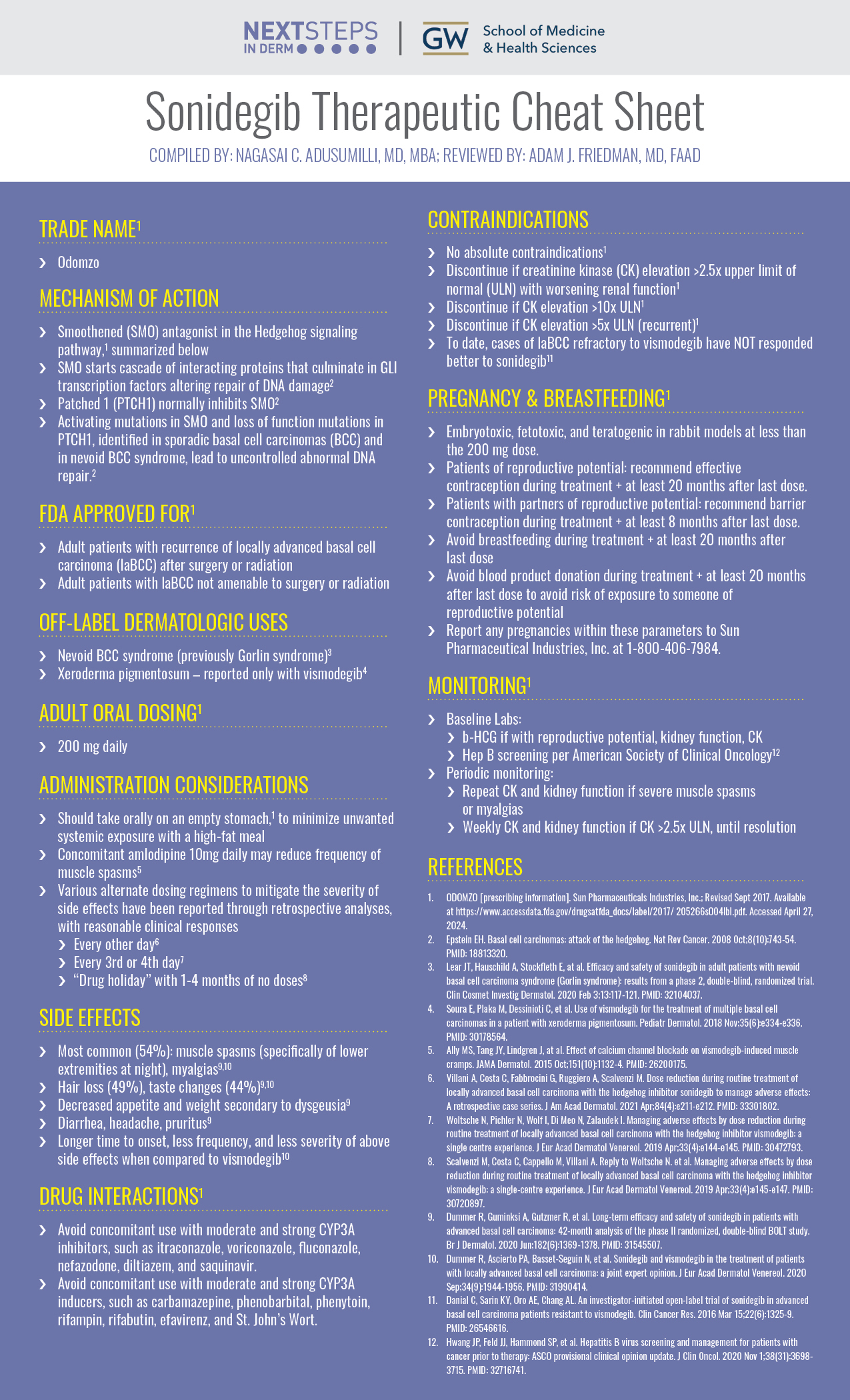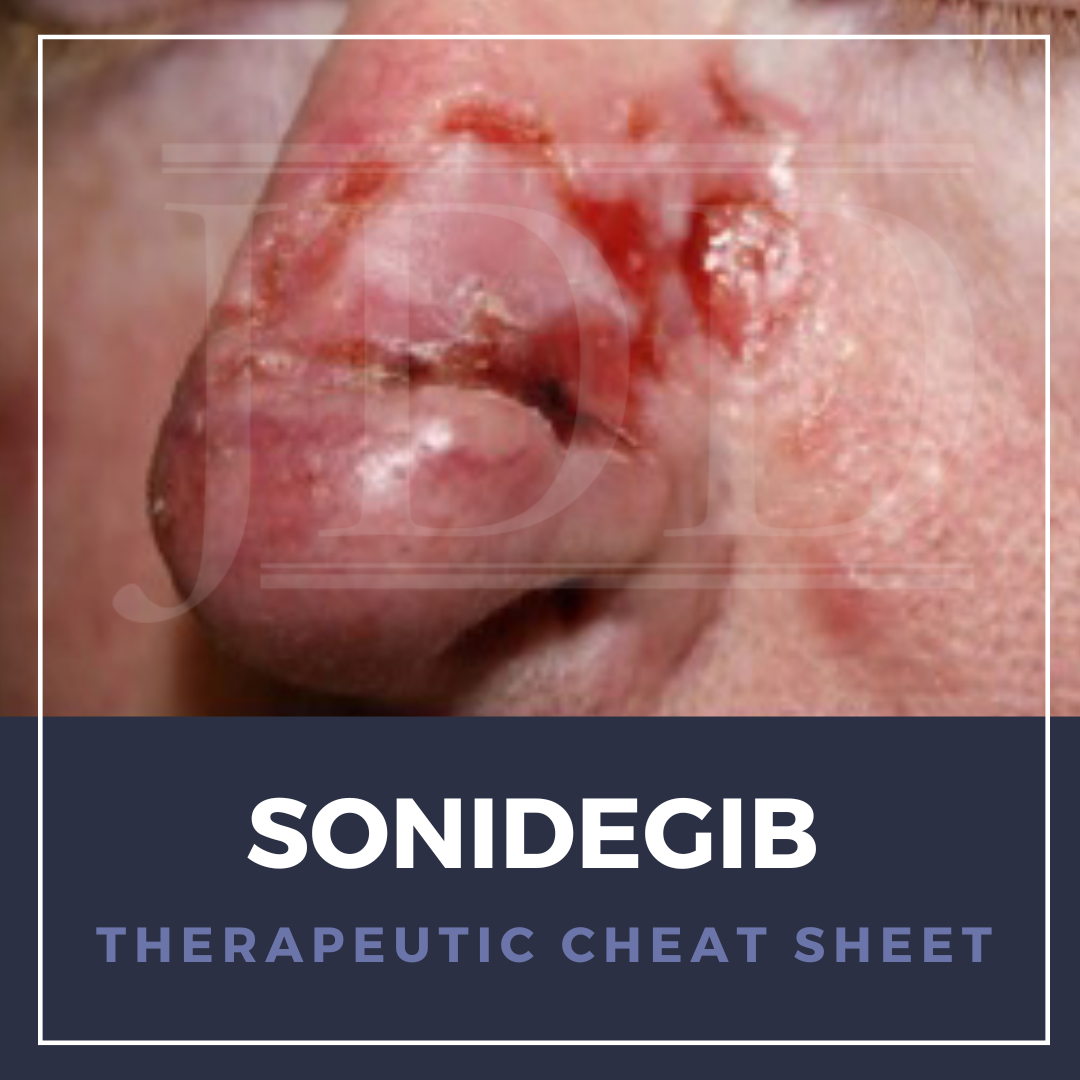Basal cell carcinoma (BCC) is the most common human cancer. When curative surgery and radiotherapy are contraindicated, systemic agents targeting the hedgehog signaling pathway are invaluable options for this subset of adult patients with locally advanced BCC (laBCC). Vismodegib and sonidegib are oral options with similar efficacy and side effect profiles. With the absence of head-to-head comparisons to date and varied designs of the pivotal trials, understanding the pharmacokinetics may provide insight into the clinical differences. We continue our series, Therapeutic Cheat Sheet, with a closer look at sonidegib, which is approved by the United States Food and Drug Administration for recurrent laBCC and laBCC inappropriate for surgery or radiotherapy. Sonidegib is also used off-label for patients with multiple BCCs, such as in nevoid basal cell carcinoma syndrome.
Sonidegib Therapeutic Cheat Sheet
Compiled by: Nagasai C. Adusumilli, MD, MBA | Reviewed by: Adam J. Friedman, MD, FAAD
TRADE NAME1
-
- Odomzo
MECHANISM OF ACTION
-
- Smoothened (SMO) antagonist in the Hedgehog signaling pathway,1 summarized below
- SMO starts cascade of interacting proteins that culminate in GLI transcription factors altering repair of DNA damage2
- Patched 1 (PTCH1) normally inhibits SMO2
- Activating mutations in SMO and loss of function mutations in PTCH1, identified in sporadic basal cell carcinomas (BCC) and in nevoid BCC syndrome, lead to uncontrolled abnormal DNA repair.2
FDA-APPROVED FOR1
-
- Adult patients with recurrence of locally advanced basal cell carcinoma (laBCC) after surgery or radiation
- Adult patients with laBCC not amenable to surgery or radiation
OFF-LABEL DERMATOLOGIC USES
-
- Nevoid BCC syndrome (previously Gorlin syndrome)3
- Xeroderma pigmentosum – reported only with vismodegib4
ADULT ORAL DOSING1
-
- 200 mg daily
ADMINISTRATION CONSIDERATIONS
-
- Should take orally on an empty stomach,1 to minimize unwanted systemic exposure with a high-fat meal
- Concomitant amlodipine 10mg daily may reduce frequency of muscle spasms5
- Various alternate dosing regimens to mitigate the severity of side effects have been reported through retrospective analyses, with reasonable clinical responses
- Every other day6
- Every 3rd or 4th day7
- “Drug holiday” with 1-4 months of no doses8
SIDE EFFECTS
-
- Most common (54%): muscle spasms (specifically of lower extremities at night), myalgias9,10
- Hair loss (49%), taste changes (44%)9,10
- Decreased appetite and weight secondary to dysgeusia9
- Diarrhea, headache, pruritus9
- Longer time to onset, less frequency, and less severity of above side effects when compared to vismodegib10
DRUG INTERACTIONS1
-
- Avoid concomitant use with moderate and strong CYP3A inhibitors, such as itraconazole, voriconazole, fluconazole, nefazodone, diltiazem, and saquinavir.
- Avoid concomitant use with moderate and strong CYP3A inducers, such as carbamazepine, phenobarbital, phenytoin, rifampin, rifabutin, efavirenz, and St. John’s Wort.
CONTRAINDICATIONS
-
- No absolute contraindications1
- Discontinue if creatinine kinase (CK) elevation >2.5x upper limit of normal (ULN) with worsening renal function1
- Discontinue if CK elevation >10x ULN1
- Discontinue if CK elevation >5x ULN (recurrent)1
- To date, cases of laBCC refractory to vismodegib have NOT responded better to sonidegib11
PREGNANCY AND BREASTFEEDING1
-
- Embryotoxic, fetotoxic, and teratogenic in rabbit models at less than the 200 mg dose.
- Patients of reproductive potential: recommend effective contraception during treatment + at least 20 months after last dose.
- Patients with partners of reproductive potential: recommend barrier contraception during treatment + at least 8 months after last dose.
- Avoid breastfeeding during treatment + at least 20 months after last dose
- Avoid blood product donation during treatment + at least 20 months after last dose to avoid risk of exposure to someone of reproductive potential
- Report any pregnancies within these parameters to Sun Pharmaceutical Industries, Inc. at 1-800-406-7984.
MONITORING
-
- Baseline Labs:
- b-HCG if with reproductive potential, kidney function, CK
- Hep B screening per American Society of Clinical Oncology12
- Periodic monitoring:
- Repeat CK and kidney function if severe muscle spasms or myalgias
- Weekly CK and kidney function if CK >2.5x ULN, until resolution
- Baseline Labs:

FURTHER READING
If you would like to learn more about sonidegib, check out the following articles in the Journal of Drugs in Dermatology:
Abstract
With immunotherapy historically focused on cutaneous melanoma, there has been a new wave of systemic medications available for treating non-melanoma skin cancers including basal cell carcinoma (BCC), squamous cell carcinoma (SCC), and Merkel cell carcinoma (MCC). The immune checkpoint inhibitors approved by the FDA target programmed cell death protein 1 (PD-1) and the Hedgehog (Hh) signaling pathway. These medications have expanded treatment options; however, side effects are an important consideration. We used the FDA Adverse Events Reporting System (FAERS) to characterize the most prevalent, real-world side effects experienced by patients on these agents. Muscle spasms (23.45%), alopecia (16.06%), ageusia (12.02%), taste disorder (11.91%), and fatigue (11.67%) were the five most common side effects reported with medications used for BCC treatment. Logistic regression analysis showed males on vismodegib for BCC having greater odds of experiencing muscle spasms (aOR 1.33, P<0.001) and ageusia (aOR 1.34, P<0.001) versus females, who were more likely to exhibit alopecia (aOR 1.82, P<0.001) and nausea (aOR 1.96, P<0.001). With SCC treatment, the 5 most reported adverse events were fatigue (5.58%), rash (3.59%), asthenia (3.59%), pruritus (3.19%), and pyrexia (2.79%). Patients taking cemiplimab-rwlc for BCC compared to SCC were more likely to experience disease progression (aOR 10.98, P=0.02). With medication labels providing an excessively daunting list of side effects, we characterize practical side effects seen in patients receiving systemic treatments for non-melanoma skin cancers.
J Drugs Dermatol. 2024;23(5):301-305.
Abstract
Basal cell carcinoma (BCC) is the most common malignancy in fair-skinned populations. Most cases are successfully treated with surgery, but in advanced BCC—including locally advanced BCC and metastatic BCC—surgery is likely to result in substantial morbidity or unlikely to be effective. In those patients, the systemic Hedgehog inhibitors (HHIs) sonidegib and vismodegib are the only approved pharmacologic treatment option. Although a number of clinical studies highlight the similarities and differences between the two HHIs, no head-to-head clinical comparison is available. Results from the pivotal BOLT and ERIVANCE clinical studies for sonidegib and vismodegib, respectively, demonstrate similar efficacy measured by objective response rate, complete response rate, and histologic tumor subtype. Safety results for both studies are comparable with similar common adverse events reported for muscle spasms, alopecia, and dysgeusia. A notable difference between sonidegib and vismodegib is their respective pharmacokinetic profiles with sonidegib reaching peak concentration in plasma within 2–4 hours of dosing and steady state in plasma achieved by week 17 of treatment, while vismodegib reaches peak plasma concentration approximately 2 days after a single dose and steady state within 21 days of repeated dosing. This review compares efficacy, safety, and pharmacokinetics of sonidegib and vismodegib based on published literature to date.
J Drugs Dermatol. 2021;20(2):156-165.
REFERENCES
-
- ODOMZO [prescribing information]. Sun Pharmaceuticals Industries, Inc.; Revised Sept 2017. Available at https://www.accessdata.fda.gov/drugsatfda_docs/label/2017/ 205266s004lbl.pdf. Accessed April 27, 2024.
- Epstein EH. Basal cell carcinomas: attack of the hedgehog. Nat Rev Cancer. 2008 Oct;8(10):743-54. PMID: 18813320.
- Lear JT, Hauschild A, Stockfleth E, at al. Efficacy and safety of sonidegib in adult patients with nevoid basal cell carcinoma syndrome (Gorlin syndrome): results from a phase 2, double-blind, randomized trial. Clin Cosmet Investig Dermatol. 2020 Feb 3;13:117-121. PMID: 32104037.
- Soura E, Plaka M, Dessinioti C, et al. Use of vismodegib for the treatment of multiple basal cell carcinomas in a patient with xeroderma pigmentosum. Pediatr Dermatol. 2018 Nov;35(6):e334-e336. PMID: 30178564.
- Ally MS, Tang JY, Lindgren J, at al. Effect of calcium channel blockade on vismodegib-induced muscle cramps. JAMA Dermatol. 2015 Oct;151(10):1132-4. PMID: 26200175.
- Villani A, Costa C, Fabbrocini G, Ruggiero A, Scalvenzi M. Dose reduction during routine treatment of locally advanced basal cell carcinoma with the hedgehog inhibitor sonidegib to manage adverse effects: A retrospective case series. J Am Acad Dermatol. 2021 Apr;84(4):e211-e212. PMID: 33301802.
- Woltsche N, Pichler N, Wolf I, Di Meo N, Zalaudek I. Managing adverse effects by dose reduction during routine treatment of locally advanced basal cell carcinoma with the hedgehog inhibitor vismodegib: a single centre experience. J Eur Acad Dermatol Venereol. 2019 Apr;33(4):e144-e145. PMID: 30472793.
- Scalvenzi M, Costa C, Cappello M, Villani A. Reply to Woltsche N. et al. Managing adverse effects by dose reduction during routine treatment of locally advanced basal cell carcinoma with the hedgehog inhibitor vismodegib: a single-centre experience. J Eur Acad Dermatol Venereol. 2019 Apr;33(4):e145-e147. PMID: 30720897.
- Dummer R, Guminksi A, Gutzmer R, et al. Long-term efficacy and safety of sonidegib in patients with advanced basal cell carcinoma: 42-month analysis of the phase II randomized, double-blind BOLT study. Br J Dermatol. 2020 Jun;182(6):1369-1378. PMID: 31545507.
- Dummer R, Ascierto PA, Basset-Seguin N, et al. Sonidegib and vismodegib in the treatment of patients with locally advanced basal cell carcinoma: a joint expert opinion. J Eur Acad Dermatol Venereol. 2020 Sep;34(9):1944-1956. PMID: 31990414.
- Danial C, Sarin KY, Oro AE, Chang AL. An investigator-initiated open-label trial of sonidegib in advanced basal cell carcinoma patients resistant to vismodegib. Clin Cancer Res. 2016 Mar 15;22(6):1325-9. PMID: 26546616.
- Hwang JP, Feld JJ, Hammond SP, et al. Hepatitis B virus screening and management for patients with cancer prior to therapy: ASCO provisional clinical opinion update. J Clin Oncol. 2020 Nov 1;38(31):3698-3715. PMID: 32716741.
Did you enjoy this Therapeutic Cheat Sheet? You can find more here.

